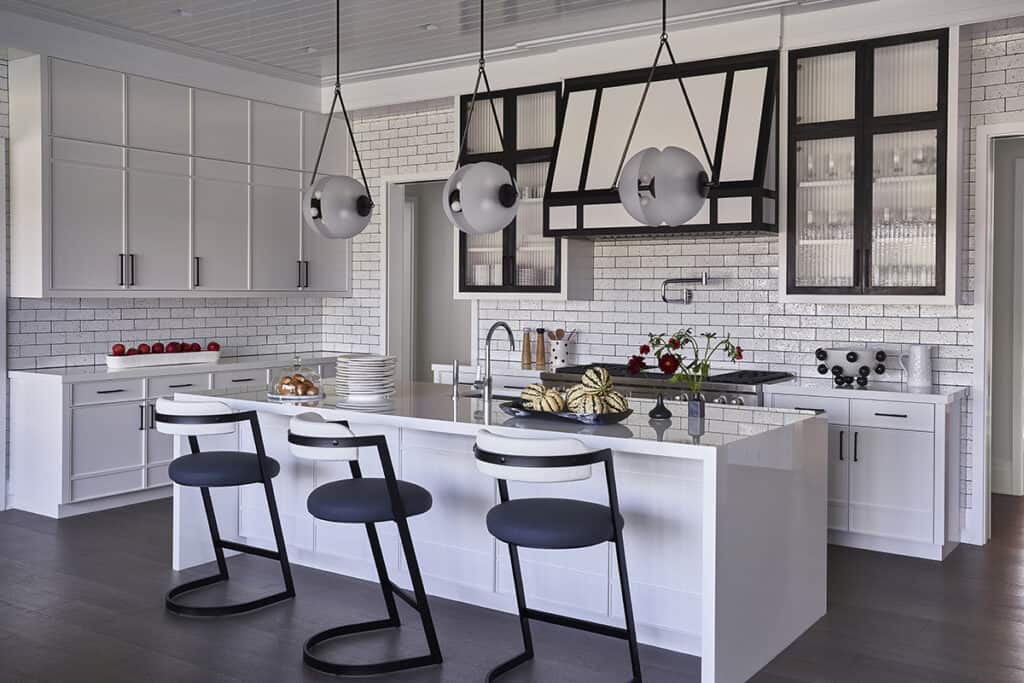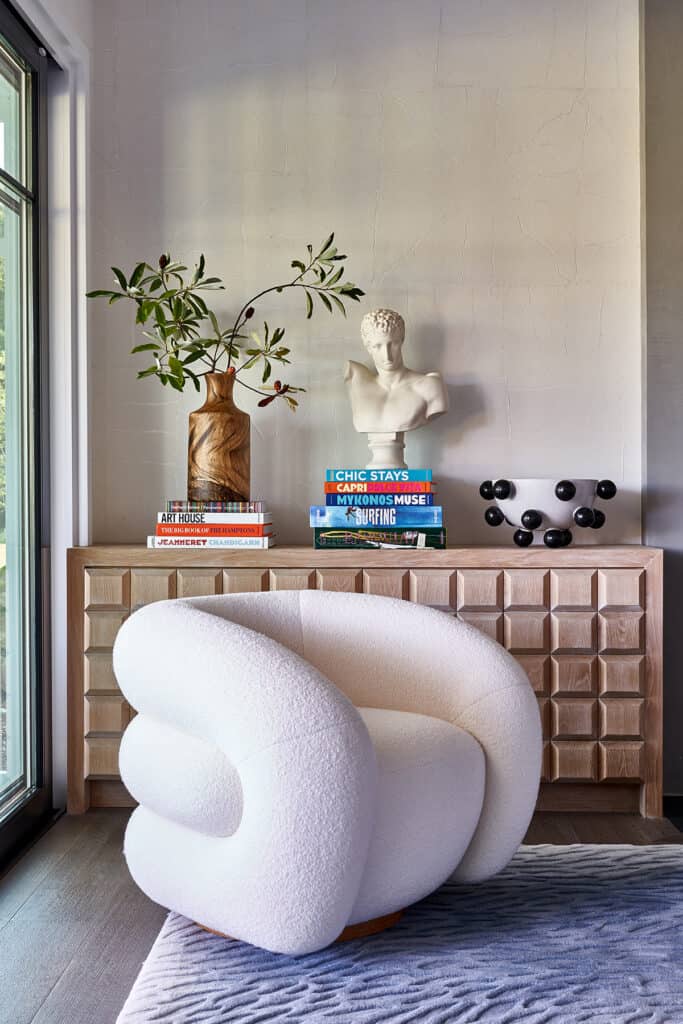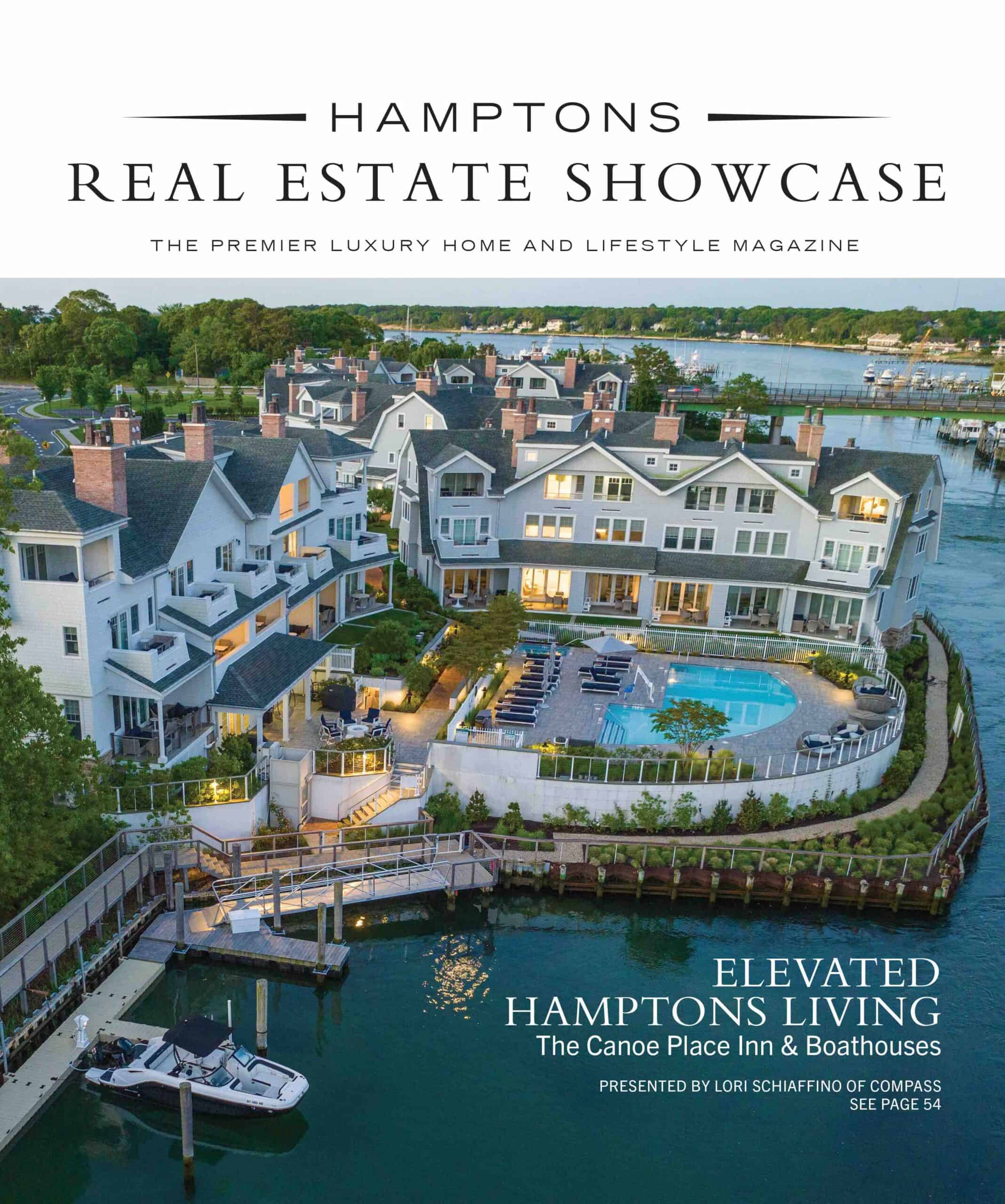The interior designer Michelle Gerson adds texture and color to a house in Water Mill, leaving minimalism in the dust
A young couple buy a plot of land in Water Mill, and on this plot of land they commission an architect to build a weekend house for their family. Eventually, the structure will span 12,000 square feet and have nine bedrooms and nine baths. When the sheetrock walls are in, but the finishes have yet to be chosen, the couple engage the designer Michelle Gerson, requesting interiors that are “modern but not minimal.”

It wasn’t so long ago that “modern” and “minimal” were considered a contradiction in terms. In some design quarters, they still are. If you tell a decorator that you’re partial to modern design, there’s a good chance they’ll be showing you mood boards with gorgeous, austere interiors à la John Pawson before too long. But Gerson correctly interpreted her client’s use of the word “modern” to mean modern-ish, minus the minimalism. For some, the term “modern,” divested of its historical connotations, is synonymous with “contemporary” (a design descriptor, Gerson says, that has faded away). Gerson posits that the recent surge of interest in soft-touch modern design may be a reaction to the prevalence of classic modern interiors with their pared-back interiors leached of color. Such rooms “look great on camera,” she says, “but they’re not so comfortable to live in.” Modern sofas, in particular, she observes, “require your best posture.”
Livability mattered a great deal to her clients, so on this project Gerson paid special attention to the comfort quotient — without compromising on style. “The clients wanted a house that looked both lived-in and of the moment,” she says. To achieve that elusive combination, she relied on mid-century gestures paired with an overall design scheme that has what she calls “a clean-lined 2020 vibe without a ton of clutter.”



Needless to say, the structure didn’t always look that way. When Gerson arrived on the scene, there was sheet rock on the walls, but “no trim or details. The kitchen wasn’t designed. The plumbing wasn’t in. The stairs were finished and the layout was done, but that was it.” Her initial efforts were focused on detail work such as adding reverse shiplap paneling and cerusing the walls with oak in situ (“Quite the production,” she recalls). And because the principal bedroom suite had an extra-high ceiling — “It made the room feel cavernous” — she decided to cover the sheet rock in rift-sawn white oak for a warming effect. Later, she designed a mohair-upholstered headboard for the bed. (At nearly eight feet tall, it required the services of eight men to carry it into the house and up the stairs.)
And because the client wanted the house to have color, Gerson chose a palette of blues. “We weren’t going for the rainbow-house look, but on the other hand, we didn’t want the colors to be too neutral either.” The idea was to deploy color in a thoughtful way, in shades that “didn’t give you a headache when you walked through the door.”

Next, Gerson set about building up layers of texture. The family room, for instance, now features a fireplace with a surround that is finished in hand-troweled concrete, a mohair sofa in periwinkle-blue, a resin coffee table poured by Martha Sturdy, and two curvy cream-colored swivel chairs of her own design. Elsewhere, she added tongue and groove doors, burlap-like wall coverings, and heaps of soft furnishings that have a distinctly tactile quality.


“At the end of the day people look at the whole picture.” They may not notice each layer of texture, she says, but it’s the accretion of “small details that create the mood in a house.” The most challenging aspect of the project, Gerson says, was to do with logistics, as she was brought on board after the project was underway. To have the house ready in time for the summer season, many decisions had to be made in rapid succession. Thus, the homeowners did not have the luxury of mulling things over, a habit of mind that has derailed many a design project.
“Often I think our first instincts are best,” she reflects. Sometimes clients will second guess themselves only to find themselves back where they began six months later. But in this case when I presented the options, they chose right and they did so right away. They put the pedal to the metal and floored it.”










![First time ever on the market, this is a unique opportunity to own in the desirable and charming Historic District in the Village of Sag Harbor. 63 Glover Street is considered the most sought-after in the Village, boasting 100± ft. of panoramic water frontage, half bulkheaded, on Sag Harbor Cove with a deep water dock and a separate living cottage. Represented by @thebestofthehamptons of @brownharrisstevens. [link in bio]](https://hamptonsrealestateshowcase.com/wp-content/uploads/sb-instagram-feed-images/488065237_18501743197030135_1061235731645102537_nfull.webp)
![Drawing inspiration from the Greek Revival style of architecture, 7 Somers Place was developed by Sag Harbor master builder, Robert Tortora. The gracious living room with mantled masonry fireplace and elevated ceilings flows to the spacious dining room and custom light-filled kitchen. Represented by @thechrisritchey and Kim Hovey of @compass. [link in bio]](https://hamptonsrealestateshowcase.com/wp-content/uploads/sb-instagram-feed-images/488012730_18501545716030135_2576407923807360973_nfull.webp)
![Elegance and intelligence abound at this waterfront masterpiece with 8,065± sq ft, 7 bedrooms and 8.5 baths. 101 Jessup Lane boasts a sweeping double stairway entry hallway, 7 romantic fireplaces, a large gathering room, formal dining room, billiard room, and exercise room with sauna. Represented by @rydbergkent of @douglaselliman. [link in bio]](https://hamptonsrealestateshowcase.com/wp-content/uploads/sb-instagram-feed-images/486626595_18501344173030135_6414454892538890571_nfull.webp)
![Discover fabulous floral finds and nature-inspired treasures to bring beauty and charm to your life. Whether you’re adding a touch of nature to your home or finding the perfect gift, these blooming delights are sure to brighten your day! [link in bio]](https://hamptonsrealestateshowcase.com/wp-content/uploads/sb-instagram-feed-images/487711988_18500839267030135_4881948075500906108_nfull.webp)
![Spring, of course, leads inexorably into another summer season here in the Hamptons. According to agents we spoke to, demand is quite strong this year for rentals. A quality medium-priced property, well presented with amenities, is eagerly sought-after. Publicly listed rentals range from a high of $2.5 million, Memorial Day to Labor Day, on Cobb Lane in Water Mill, with quite a few more $1 million plus rentals than usual. [link in bio]](https://hamptonsrealestateshowcase.com/wp-content/uploads/sb-instagram-feed-images/486541532_18500603206030135_1827695170316201968_nfull.webp)
![Perched atop the dunes at Louse Point sits a picturesque house, perfect for enjoying all seasons that East Hampton has to offer. Situated on three quarters of an acre with almost 360 degree views of Gardiner’s Bay and Accabonac Harbor, 86 & 88 Louse Point are truly unique. Represented by @petrieteam of @compass. [link in bio]](https://hamptonsrealestateshowcase.com/wp-content/uploads/sb-instagram-feed-images/486615712_18500408650030135_1498783920053065135_nfull.webp)
![Set to be completed this year, this extraordinary property spans 2.5± acres of cleared land and showcases over 12,125± sq. ft. of architectural sophistication and refined design. With 9 bedrooms, 11 full baths, and 2 half baths, 261 Millstone Road offers an exceptional blend of spaces for both relaxation and entertainment. Represented by @susan.breitenbach of @thecorcorangroup. [link in bio]](https://hamptonsrealestateshowcase.com/wp-content/uploads/sb-instagram-feed-images/486599655_18500185618030135_8926656954621895711_nfull.webp)

